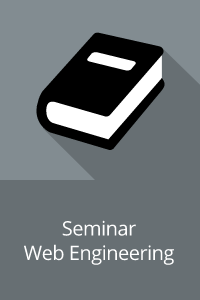
Seminar Web Engineering (SS 2020)
Welcome to the homepage of the Seminar Web Engineering
This website contains all important information about the seminar, including links to available topics as well as information about the seminar process in general.
The interdisciplinary research area Web Engineering develops approaches for the methodological construction of Web-based applications and distributed systems as well as their continuous development (evolution). For instance, Web Engineering deals with the development of interoperable Web Services, the implementation of web portals using service-oriented architectures (SOA), fully accessible user interfaces or even exotic web-based applications that are voice controlled via the telephone or that are represented on TV and Radio.
The following steps are necessary to complete the seminar:
- Preparation of a presentation about the topic assigned to you.
- An additional written report of your topic.
- Each report is reviewed by two or three other particpants.
Seminar chairs


Contact
If you have any questions concerning this course or the exam as a participant, please contact us via OPAL.
We also offer a Feedback system, where you can provide anonymous feedback for a partiular session to the presenter on what you liked or where we can improve.
Participants
The seminar is offered for students of the following programmes (for pre-requisites, please refer to your study regulations):
- Bachelor Informatik (Proseminar 500110 /Hauptseminar 500070)
- Bachelor Angewandte Informatik (Proseminar 500110 / Hauptseminar 500270)
- Bachelor Informatik und Kommunikationswissenschaften (Proseminar 500110 / Hauptseminar 500070)
- Master Informatik für Sozial- und Geisteswissenschaftler (Proseminar 500110 /Forschungsseminar 500090)
- Master Informatik (Forschungsseminar M_01)
- Master Angewandte Informatik (Forschungsseminar 500090)
- Master Web Engineering (Seminar Web Engineering 500410)
If your programme is not listed here, please contact us prior to seminar registration and indicate your study programme, the version (year) of your study regulations (Prüfungsordnungsversion) and the module number (Modulnummer) to allow us to check whether we can offer the seminar for you and find an appropriate mapping.
Registration
You may only participate after registration. The registration opens on 14.04.2020 at 12:00 and ends on 20.04.2020 at 23:59. There is an overall capacity of 20 slots available. As these slots are usually rather quickly booked, we recommend to complete your registration early after registration opens.
If you cannot get a free slot in the corresponding group (PS/HS/FS/WE), you will be added to the waiting list. Please subscribe to the course via OPAL to receive email notifications. We ask all students on the waiting list to attend the opening meeting as we will fill up unused quotas from the waiting lists. If you have already unsuccessfully attempted to join the seminar for several times in previous semesters, please write an email to maik.benndorf@informatik.tu-chemnitz.de prior to the opening meeting. We will then check your registration history and, if possible, treat you with higher priority when filling up free slots.
You may only participate after registration. The registration is closed. Please try again in the following semester.
Topics and Advisors
Questions:
- Why is the structured annotation of research datasets necessary and useful?
- Conduct a systematic analysis of existing relevant application profiles and vocabularies.
- Compare the identified solutions and present your systematic approach and results.
Questions:
- How can we extract structured, content-related information from multimedia files, tabular files, source code and other relevant research artifacts, excluding scientific text documents.
- Conduct a systematic analysis of existing relevant tools that support automatic information extraction.
- Compare the identified solutions and present your approach and results.
Questions:
- What are DataHubs and Research Data Management Systems (RDMS)?
- Conduct a systematic analysis of existing, web-based tools and solutions such as CKAN, DKAN/Drupal, DSpace, Dataverse, Invenio/Zenodo and others
- Compare the identified solutions and present your systematic approach and results, especially related to interdisciplinary research dataset exchange.
Questions:
- How can you include Forgiveness and Regret in a Content Trust Model?
- Why would these concepts enhance the Content Trust model?
Questions:
- What are CEPS?
- What are important properties of cross-domain CEPS?
- What are open challenges in cross-domain CEPS?
Questions:
- Why is trust on linked data an important aspect?
- What are common metrics for assesing data trust in certain linked data?
- What are limits of current linked data trust assessments?
Literature:
Questions:
- What is it?
- How can it be used for research data management?
- How does it compare to other data management platforms?
Literature:
- Own research
Questions:
- What is it?
- How can it be implemented?
- How can it be applied to IoT application?
Literature:
- Domain-Driven Design:Tackling Complexity in the Heart of Software, Eric Evans
Questions:
- What is the difference to Big Data?
- How can we query a large number of small data sources instead of a small number of large ones?
- Which challenges exist when querying data storages in SoLiD based environments?
Questions:
- What is it?
- What are the limitations?
- What is the difference compared to Social network aggregation?
- What are the known approaches / implementations?
Questions:
- What is it?
- What are the known approaches / implementations?
- Compare the APIs from the social networks
Questions:
- What is it?
- Known approaches / implementations
Questions:
- How can the "data-driven organization" be applied in the context of university?
- Name several real use cases of applying data-driven in universities?
Questions:
- What is a Lucidwork-Banana tool? How can we use it to visualize data?
- What are the alternatives? Compare the Lucidwork-Banana tool with the alternatives.
Questions:
- What is State of the Art Analysis in Data Integration approaches?
- Compare Data Integration approaches?
Questions:
- What is it?
- How to provide contextual information (e.g., location) to other applications?
- What are the advantages compared to other existing solutions?
Questions:
- What are the use cases?
- Which browsers support this?
- What are the differences to other existing solutions i.e. Physical Web
- How to integrate an IoT device (sensor or actuator)?
Literature:
Questions:
- What is Object Detection?
- What are state of the art solutions?
- Provide a structured comparison of general purpose object detection in images vs UI object detection in Web User Interfaces (characteristics that make it easier such as lack of light differences, perspectives, noise etc. and characteristics that make it harder e.g. high visual similarity of UI objects, small size of objects, background images etc.).
Literature:
- Felzenszwalb HOG, RPNs, Faster RCNN, Mask RCNN, YOLO, Browserbite
- https://arxiv.org/pdf/1803.02129.pdf
- https://blog.athelas.com/a-brief-history-of-cnns-in-image-segmentation-from-r-cnn-to-mask-r-cnn-34ea83205de4
- https://acadpubl.eu/hub/2018-118-24/4/694.pdf
Questions:
- What is it?
- How can they be used for research data management?
- How do they compare to traditional, domain-specific ontologies?
Questions:
- Why is data quality in the meta-description of scientific datasets important?
- What is the FAIRmetrics project and how can these metrics be implemented and measured?
- What are alternative approaches and how do they compare to FAIRmetrics?
Questions:
- Identify a list of all IoT device categories that can be used in the smart home domain
- What are the key information that needs to be extracted from IoT devices to enable application development on top of them?
- What are the techniques (or sources of information) in the literature for extracting the functionalities of IoT devices automatically? (e.g., knowledge graphs, natural language processing over IoT device APIs, etc.)
- How do the existing knowledge graphs (e.g., ConceptNet, WordNet, wikiData, Microsoft Concept Graph) compare to each other in terms of support for 1) wide coverage of device categories, 2) API support etc.
- For demo purposes use ConceptNet to automatically extract the capabilities of the device types identified in step 1.
Literature:
- http://conceptnet.io/
- A3ID: An Automatic and Interpretable Implicit Interference Detection Method for Smart Home via Knowledge Graph, IEEE Internet of Things Journal, 2019
Questions:
- Why is automated testing of IoT services important, provide use cases?
- What are the different approaches for automated testing of IoT services in the literature and provide comparison?
- What are the technologies used in this domain?
Literature:
Questions:
- What is the idea of a Knowledge Graph for Research?
- Which vocabularies do they use for annotating research?
- Which technologies are used to realize the ORKG?
Questions:
- What models can be used for Indoor Mapping?
- In which ones can you change object positions and how?
- Present the model that is best for this and explain your reasoning
Questions:
- Which AR frameworks are available for Android?
- Compare them based on their technical specifications, cost and how they are programmed.
- Choose one framework and program a simple AR application to measure objects.
Questions:
- What are current approaches for generating web applications from mockups, in particular hand-drawn mockups? How do they work? Who uses them?
- Compare existing approaches with regard to techniques used, results quality, restrictions of input/output.
- What are current limitations? Are there empirical studies with users/designers exploring utility/time and effort improvements/flexibility? How are different camera perspectives handled? What about variable size input/aspect ratio?
Literature:
- https://sketch2code.azurewebsites.net/
- https://airbnb.design/sketching-interfaces/
- https://github.com/Microsoft/ailab/tree/master/Sketch2Code
- https://github.com/tonybeltramelli/pix2code
- https://arxiv.org/abs/1810.11536
- https://repositorio-aberto.up.pt/bitstream/10216/122189/2/351046.pdf
- https://dl.acm.org/doi/10.1145/3264746.3264807
- https://arxiv.org/abs/1905.13750
- https://ieeexplore.ieee.org/document/8374985
- https://dl.acm.org/doi/abs/10.1145/3292448.3292455
- https://arxiv.org/abs/1910.08930
- https://dl.acm.org/doi/abs/10.1145/3220134.3220135
- https://dl.acm.org/doi/abs/10.1145/3290607.3312994
- http://ksiresearchorg.ipage.com/seke/seke16paper/seke16paper_231.pdf
- https://www.producthunt.com/posts/artyline
- https://ieeexplore.ieee.org/document/7372013
Questions:
- What is the motivation for synthesizing training dataset? Where has this been applied successfully? How does it relate to Transfer Learning?
- What are common approaches for training dataset synthesis? How is a high similarity with the equivalent real data measured and ensured? How are Generative Adversarial Network (GANs) used for training dataset generation?
- Which characteristics (e.g. variance, parameter distributions, required dataset size, measures to ensure close reproduction of reality etc.) are required/suitable for dataset synthesis? Are there studies investigating general rules/limitations/recommendations for applicability?
Literature:
- https://arxiv.org/abs/1603.07057
- https://arxiv.org/abs/1904.11621
- https://arxiv.org/abs/1807.07521
- https://dl.acm.org/doi/10.1145/3290607.3312994
- VISH: Does Your Smart Home Dialogue System Also Need Training Data?
- https://arxiv.org/abs/1707.07410
- https://arxiv.org/abs/1703.06907
- https://arxiv.org/abs/1808.06910
- https://ai-alignment.com/synthesizing-training-data-f92a637dc1b4
- https://towardsdatascience.com/synthetic-data-generation-a-must-have-skill-for-new-data-scientists-915896c0c1ae
- https://www.technologyreview.com/2016/09/12/157605/self-driving-cars-can-learn-a-lot-by-playing-grand-theft-auto/
Seminar Opening
The seminar opening will be held on Tuesday, 28/04/2020 virtually at 15:30 via TU-Chemnitz BigBlueButton. You can find more information on the room via OPAL.
Short Presentation
The date and time of the Short Presentation will be announced here and via OPAL.
In your short presentation, you will provide a brief overview on your selected topic.
This includes the following aspects:
- What is in your topic?
- Which literature sources did you research so far?
- What is your idea for a demonstration?
The short presentation should be no longer than 3 slides (in addition to your title slide) and take max. 5 minutes. Following your short presentations, the advisors will provide you with feedback and hints for your full presentations.
Hints for your Presentation
- As rule of thumb you can plan for 2 minutes per slide. Significantly more slides per minute can be difficult to perceive for the audience.
- Prior to creating your presentation, you should think about: What should be the main message of my presentation? What should the audience remember after my presentation?
Based on these considerations you should create your presentation. - Here you can find some useful hints http://www.garrreynolds.com/Presentation/
Seminar Days
The date and time of the Seminar Opening meeting will be announced here and via OPAL.
Report
- Important hints on citing:
- Any statement which does neither belong to general knowledge nor stem from the author has to be provided with a reference to its original source.
- "When to Cite Sources"- Good overview by Princeton University
- Examples for citations can be found in the IEEE Citation Reference
- Web References have to be cited with author, title, date, URL and date of last access. Examples:
- [...] M. Nottingham and R. Sayre, "The Atom Syndication Format - Request for Comments: 4287", 2005. [Online]. Available: http://www.ietf.org/rfc/rfc4287.txt. [Accessed: Feb. 18, 2008].
- [...] Microsoft, "Microsoft Office SharePoint Server 2007 Homepage", 2007. [Online]. Available: http://office.microsoft.com/en-us/sharepointserver/. [Accessed: Jan. 02, 2007].
- The url has to be included as a hyperlink ("clickable") if technically possible.
- Further Information and Hints:
- Please use, as far as possible, the HTML elements which are used in the template. Changes to the CSS file are not allowed and will be ignored.
- Carefully check spelling and grammar of your reports, preferably using software support such as OpenOffice, Microsoft Word or LanguateTool, before uploading it.
- Check that your HTML is valid using the W3C Validator
Review
- Each seminar participant has to review exactly three reports. The reviews are not anonymous.
- Use the review forms provided in the VSR Seminar Workflow, one per report.
- Following the review phase, each seminar participant will receive the three peer reviews of his report and, if necessary, additional comments by the advisors. You will then have one more week to improve your report according to this feedback.
- The seminar grade will consider the final report.
All comments in the reviews are for improving the text and therefore in the interest of the author.


